Detroit artist Kate Hanley has been creating sculptural mosaics using the skulls of animals to raise awareness of environmental issues threatening their existence since 2014. By showcasing the allure of the skulls through her art, Hanley raises interest in and encourages advocacy for the protection of the habitats in which these animals live and enrich our world.
She believes “everyone is struck with wonder when viewing animals in their natural habitat. We experience a truth that this is the animal’s domain, they are in control and in their element–we are simply observers.” Her skull mosaics offer a new way of seeing wildlife.
“Celebrating the unending beauty of the animal, even in death, is an artistic goal,” she says in an interview with Arts Help.
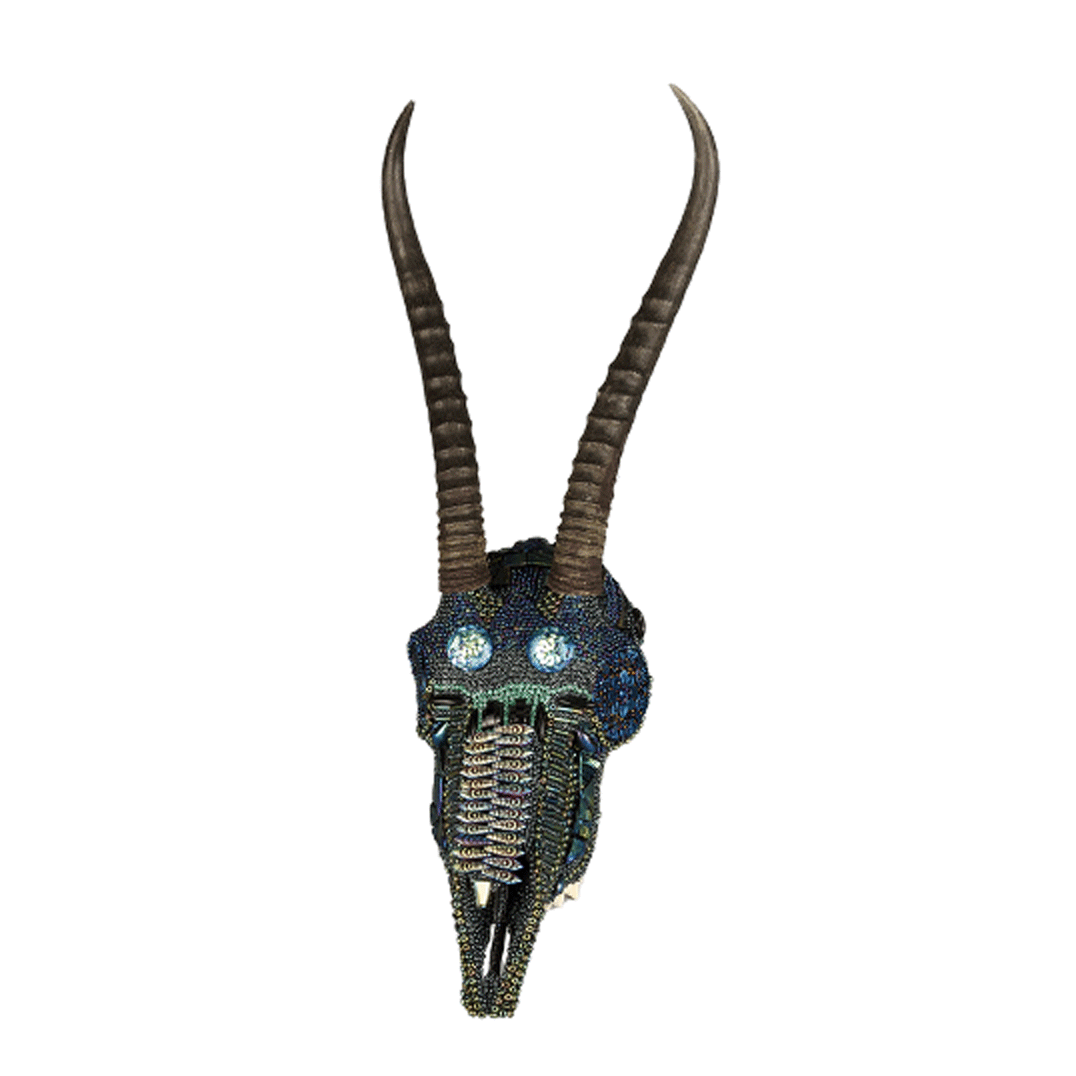
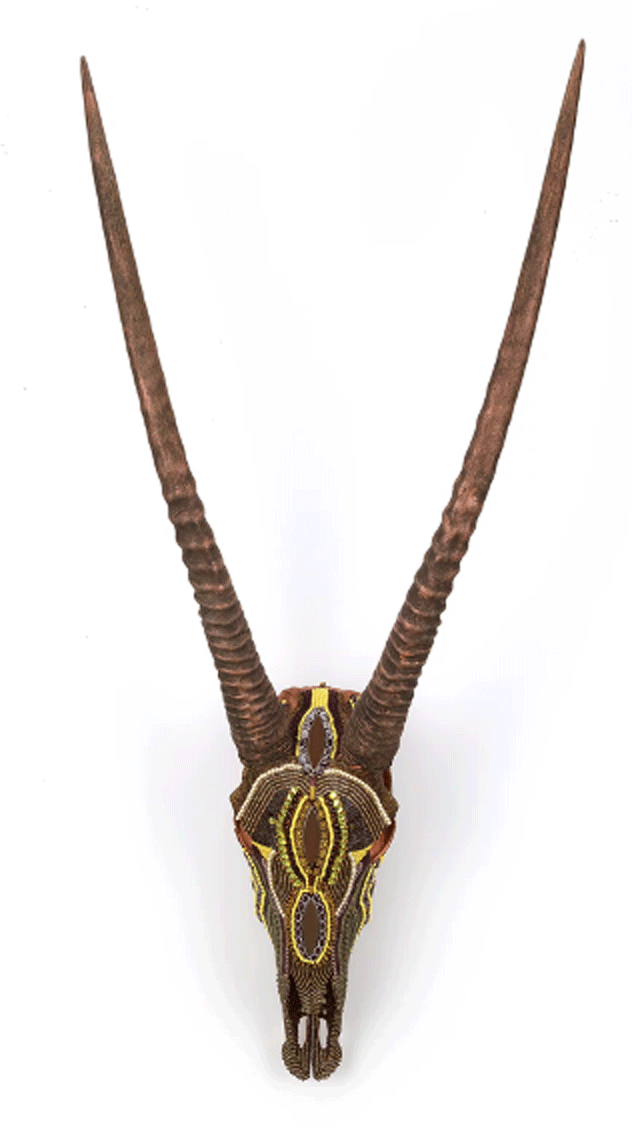

The skulls of many of the larger animals that Hanley uses are byproducts of the farming industry, purchased from licensed suppliers in the United States and abroad. Through her work, Hanley hopes to increase appreciation for the inherent dignity of the animals she represents: “Animal skulls have a natural elegance, and following the contours is fascinating and inspiring.”
Kate Hanley’s environmentally conscious skull mosaics touch on several United Nations Sustainable Development Goals (SDGs) including Life on Land, Climate Action, Responsible Consumption and Production, Clean Water and Sanitation, No Poverty and Zero Hunger.

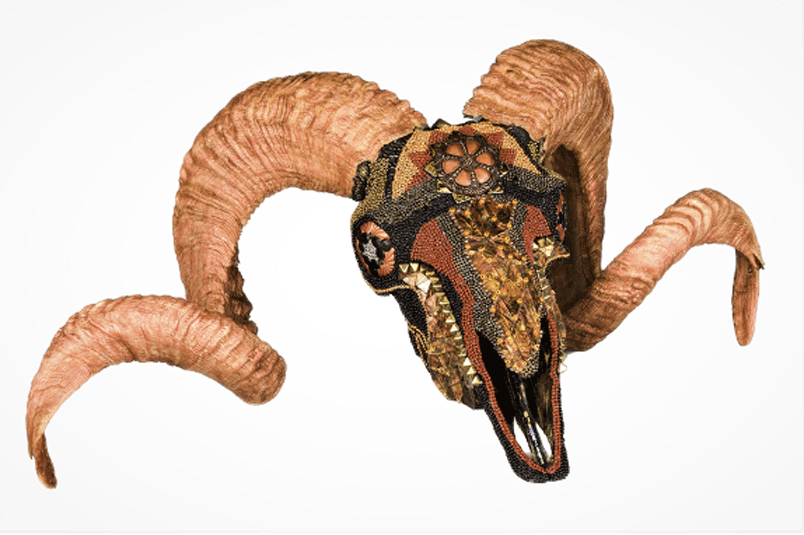
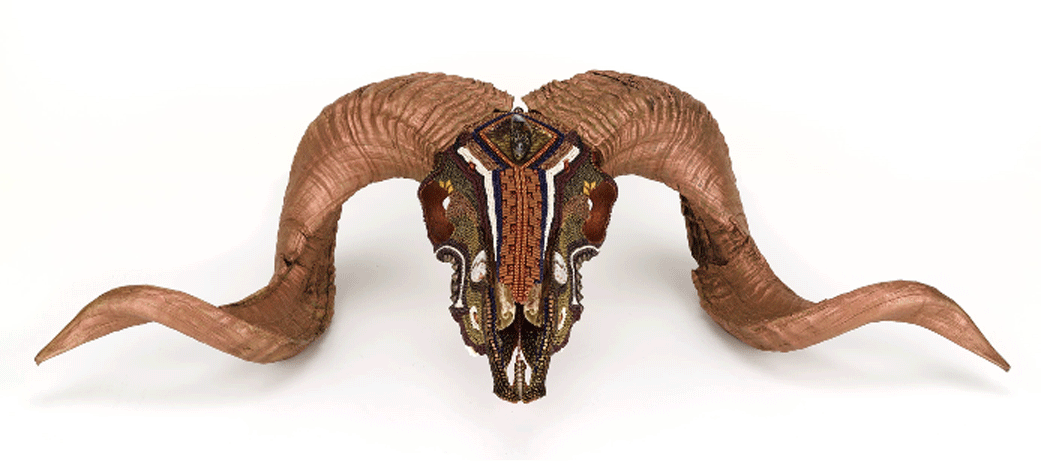
Hanley began beading skulls after she saw a glass mosaic woodland mural at the Grand Rapids Art Prize in 2014. In a July 25, 2021, e-mail interview, Hanley said the work “blew her away” and she knew immediately that was what she wanted to do – create art in which she could incorporate both her love for wild animals and advocate for the environmental challenges they face in the wild.
“People are intrigued when they see the beaded skulls and always want to talk about how and why,” she said. The driving force behind Hanley’s skull art is a desire to communicate the importance of these creatures to the world and why they must be protected.
“Many people don’t know anything about the blesbok, eland or impala antelope and the fact that these are skulls and real horns intrigue them. Letting people know that these animals exist and could become endangered is a start,” Hanley says.


Hanley primarily works with various types of horned antelope including the blesbok, eland, gemsbok, impala, kudu and springbok, and ram skulls from Africa that fascinate her with their majestic shapes and markings. She also works with the skulls of North American animals both horned and not including bison, longhorn steers, bighorn rams, coyotes, and red foxes. All have seen a decrease in numbers due to human-made impacts.
Some animals, such as bison and longhorn steers, were almost hunted to extinction and can “teach us lessons from history if we are willing to listen”. Bison remain near endangered while longhorn steers are still critically endangered. Habitat loss, competition for grazing, climate change and trophy hunting are ongoing issues worldwide that challenge the existence of wild animals.


“The challenge of creating a design that honors the animal’s spirit and demonstrates the elegance and power that were part of their living persona stirs my imagination and energizes my work. Finding animals with majestic horns or antlers and working with a wide variety of skull structures is a deeply moving experience,” says Hanley when describing her artistic process.
She begins with a focal area on the forehead. “I spend hours with every skull looking for elements that I feel work and create a sense of power or serenity, dignity or boldness, grace or courage. The design is created as I move from the center of the skull and can change without real intention but as a response to the structure of the bone.”
She integrates non-traditional elements into the design ranging from rhinestones, stained glass, ceramics and smalti (hand-cut opaque coloured glass tiles) to elements that blend with the piece such as beads, buttons, shells, gemstones, vintage jewelry and other decorative objects as well as paint and glaze.
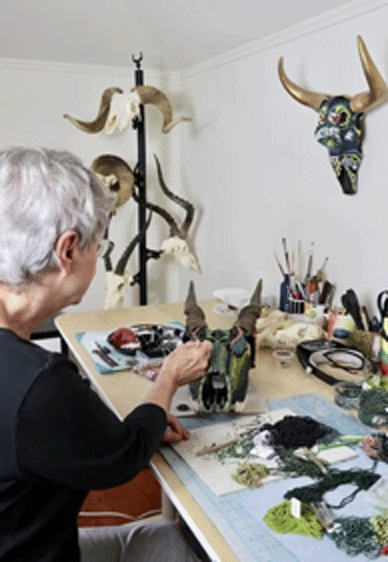

Hanley usually employs a silicone adhesive to adhere the items to the skulls as it holds the pieces well while allowing her to move each for a short period of time. She uses Apoxie Sculpt for larger or heavier elements, which combines the flexibility of clay with the holding power of epoxy. Most of the beads, tiles and other items must be placed one at a time and the entire painstaking process itself takes Hanley up to 30 hours for a small coyote and between 100 to 150 hours for a large work like a bison, depending on the materials used. Hanley says “it becomes a meditation and a type of symbiotic process, with the animal directing the design and together creating a work of art.”

To date, Hanley has created 27 skull mosaics. Some notable works include Reflecting Rhythms Sprinkbok Skull, Taranis Ram Skull, Ammon Bighorn Ram Skull, Bos Taurus Longhorn Steer Skull, Elisi Bison Skull, Aja Eland Skull, Oko Kudu Skull, Belaire Impala Skull, Verdant Veritas Blesbok Skull, Desert Journey Gemsbok Skull, Moxie Red Fox Skull and Mohawk Wiley Coyote Skull. Hanley loves sharing photos of the actual animals with people at art exhibitions so they can understand the dignity and majesty of the animal and realize what inspires her.


Although a vegetarian herself, Hanley believes that those eating meat should strive to use all parts of the animal. Incorporating a zero-waste approach could be said to be a focus of her work. Hanley continues: “The fact that these animals are part of the food production process helps to ensure they are not being unlawfully hunted.”
Hanley is also personally involved in local, national, and international wildlife conservation and preservation efforts providing financial support to organizations such as the Worldwide Wildlife Fund, Nature Conservancy, Ocean Conservancy and environmental efforts in Michigan including clean water in the Great Lakes.
Hanley further keeps herself politically informed, endorsing candidates who support measures for addressing the climate, biodiversity and pollution emergencies we face today and following the recommendations laid out in the United Nations Environmental Programme’s (UNEP) Making Peace with Nature report outlining the actions needed to produce lasting change.
Co-funded by the European Union and the Norwegian Ministry of Climate and Environment, “Making Peace with Nature: A scientific blueprint to tackle the climate, biodiversity and pollution emergencies” was released February 18, 2021, ahead of the fifth United Nations Environmental Assembly (UNEA-5) held online from Nairobi, Kenya February 22-23. It identifies the global shifts needed to close the gaps between current environmental actions and those needed to achieve sustainable development within the framework of the Sustainable Development Goals.
According to the UN Environmental Programme, the Making Peace with Nature blueprint provides solutions for how “the world can transform its relationship with nature and tackle the climate, biodiversity loss, and pollution crises together to secure a sustainable future and prevent future pandemics.”
The message Hanley wants people to take away from her skull mosaics is simple: to fall in love with a piece. As an art collector, Hanley says “if people are taken by the beautiful shape of the skull and horns that will bring the questions of how it was made and what the piece was about. With their curiosity piqued, they can go on to learn more about the animal, where they are from and how they live and sustain themselves. Beginning to understand what each species brings; how unique they are and their value in our world leads to a true appreciation for biodiversity.”
Hanley maintains that “only by knowing and appreciating the wild animals of our world can we truly become cognizant of our obligation to protect their habitats.” By showing people photos of the animals in the wild alongside their beaded and embellished skulls, Hanley hopes to stimulate discussion that will lead to an understanding of the fragility of their existence and address the issues of habitat loss, decreased food and fresh water sources, climate change, global warming, illegal poaching, trophy hunting and deforestation – all caused by humans – that have impacted their populations.
Hanley acknowledges that the resolutions to these problems are complex, including the related issues of how to reduce poverty and pollution, prevent starvation and access clean water and sanitation while protecting wildlife habitat and limiting hunting in areas of Africa and the world where people depend on these animals for food and the land they occupy for their livelihoods. Yet, as Hanley reiterates, “Many people don’t know anything about the blesbok, eland, or impala antelope and the fact that these are skulls and real horns intrigues them. If I can show them photos of the animals the discussion can lead to an understanding of the fragility of their existence and how to address the issues.”
To see more of Kate Hanley’s stunning beaded skulls, visit her website.
